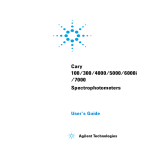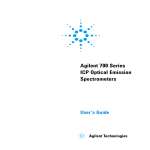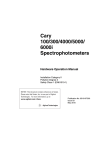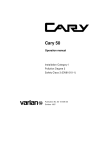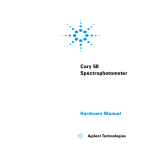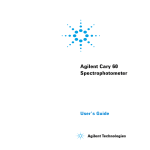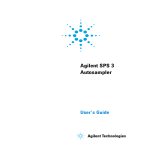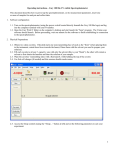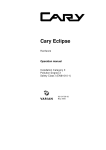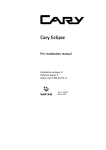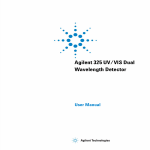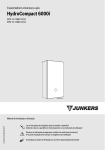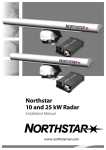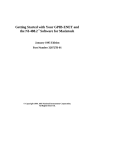Download Cary 100/300/4000/5000/6000i
Transcript
Cary 100/300/4000/5000/6000i Spectrophotometers User’s Guide Warranty Notices © Agilent Technologies, Inc. 2002, 2010-2012 No part of this manual may be reproduced in any form or by any means (including electronic storage and retrieval or translation into a foreign language) without prior agreement and written consent from Agilent Technologies, Inc. as governed by United States and international copyright laws. Manual Part Number 8510197200 Edition Seventh edition, October 2012 Agilent Technologies, Inc. The material contained in this document is provided “as is,” and is subject to being changed, without notice, in future editions. Further, to the maximum extent permitted by applicable law, Agilent disclaims all warranties, either express or implied, with regard to this manual and any information contained herein, including but not limited to the implied warranties of merchantability and fitness for a particular purpose. Agilent shall not be liable for errors or for incidental or consequential damages in connection with the furnishing, use, or performance of this document or of any information contained herein. Should Agilent and the user have a separate written agreement with warranty terms covering the material in this document that conflict with these terms, the warranty terms in the separate agreement shall control. Technology Licenses The hardware and/or software described in this document are furnished under a license and may be used or copied only in accordance with the terms of such license. Restricted Rights Legend If software is for use in the performance of a U.S. Government prime contract or subcontract, Software is delivered and licensed as “Commercial computer software” as defined in DFAR 252.227-7014 (June 1995), or as a “commercial item” as defined in FAR 2.101(a) or as “Restricted computer software” as defined in FAR 52.227-19 (June 1987) or any equivalent agency regulation or 2 contract clause. Use, duplication or disclosure of Software is subject to Agilent Technologies’ standard commercial license terms, and nonDOD Departments and Agencies of the U.S. Government will receive no greater than Restricted Rights as defined in FAR 52.227-19(c)(1-2) (June 1987). U.S. Government users will receive no greater than Limited Rights as defined in FAR 52.227-14 (June 1987) or DFAR 252.227-7015 (b)(2) (November 1995), as applicable in any technical data. Safety Notices CAUTION A CAUTION notice denotes a hazard. It calls attention to an operating procedure, practice, or the like that, if not correctly performed or adhered to, could result in damage to the product or loss of important data. Do not proceed beyond a CAUTION notice until the indicated conditions are fully understood and met. WARNING A WARNING notice denotes a hazard. It calls attention to an operating procedure, practice, or the like that, if not correctly performed or adhered to, could result in personal injury or death. Do not proceed beyond a WARNING notice until the indicated conditions are fully understood and met. Cary 100/300/4000/5000/6000i Spectrophotometers User’s Guide Safety Practices and Hazards Contents 1. Safety Practices and Hazards 7 Ultraviolet radiation 8 Electrical hazards 8 Other precautions 9 Warning and caution messages 10 Information symbols 11 Color coding 12 CE compliance 13 Electromagnetic compatibility 13 EN55011/CISPR11 ICES/NMB-001 2. Introduction 13 14 15 Installation requirements 15 Documentation 15 Conventions Specifications Environmental Weights and dimensions Power Connections Gas supplies Cary 100/300/4000/5000/6000i Spectrophotometers User’s Guide 16 16 16 17 17 17 18 3 Safety Practices and Hazards 3. Installation 19 Preparation 20 Software installation on a new computer 21 Upgrade existing Cary WinUV software 22 Starting the software 25 Software Status Bulletin 26 GPIB communications 26 USB-GPIB-HS converter PCI-GPIB Setting up the instrument 30 Cabling Power 30 30 Turning on the system 31 Instrument performance tests 32 Sample holders 32 Cell holders Solid sample holder (Cary 4000/5000/6000i only) 32 36 Installing the base plate 41 Installing other accessories 41 Nitrogen purging 42 Cary 100/300 Cary 4000/5000/6000i Removing the sample compartment base Cary 100/300 Cary 4000/5000/6000i 4 26 27 42 42 45 45 45 Cary 100/300/4000/5000/6000i Spectrophotometers User’s Guide Safety Practices and Hazards 4. Maintenance 47 Cleaning 48 Source lamps 48 Fuses 49 220–240 AC 100-120 VAC Spare Parts Cary 100/300/4000/5000/6000i Spectrophotometers User’s Guide 49 49 50 5 Safety Practices and Hazards This page is intentionally left blank. 6 Cary 100/300/4000/5000/6000i Spectrophotometers User’s Guide Safety Practices and Hazards 1. Safety Practices and Hazards Ultraviolet radiation Electrical hazards Other precautions Warning and caution messages Information symbols Color coding CE compliance Electromagnetic compatibility 8 8 9 10 11 12 13 13 Your Agilent Cary instrument and accessories have been carefully designed so that when used properly you have an accurate, fast, flexible and safe analytical system. If the equipment is used in a manner not specified by the manufacturer, the protection provided by the equipment may be impaired. Information on safety practices appears throughout the documentation (both printed and online) provided with your instrument and accessories. Before using the instrument or accessories, you must thoroughly read these safety practices. Observe all relevant safety practices at all times. Cary 100/300/4000/5000/6000i Spectrophotometers User’s Guide 7 Safety Practices and Hazards Ultraviolet radiation The deuterium (standard in all instruments) and mercury lamps (if fitted) in the instrument emit hazardous ultraviolet (UV) radiation. This radiation can cause serious damage to eyes. NEVER look directly at either lamp and NEVER operate either lamp unless it is correctly mounted in the lamp turret (Cary 4000/5000/6000i only) and the turret is correctly mounted in the instrument. NOTE The mercury lamp is fitted as standard in the Cary 4000/5000/6000i. Ozone can be generated by radiation from the source lamps. Exposure to ozone can result in severe irritation to the skin, eyes, and upper respiratory system. The maximum permissible exposure level is 0.1 parts per million (0.2 milligrams per cubic meter). ALWAYS ventilate the area surrounding the spectrophotometer such that the concentration of ozone does not exceed the maximum permissible level. All venting must be to outside air, never within the building. Electrical hazards The Cary 100/300/4000/5000/6000i instruments and some accessories contain electrical circuits, devices, and components operating at dangerous voltages. Contact with these circuits, devices and components can cause death, serious injury, or painful electrical shock. Panels or covers which are retained by screws on the spectrophotometer and accessories (with the exception of the lamp access cover) may be opened ONLY by Agilent-trained, Agilentqualified, or Agilent-approved service engineers. Consult the manuals or product labels supplied with your computer, monitor and printer to determine which parts are operator-accessible. Operators and other unauthorized personnel are permitted access ONLY to the lamp compartment and the sample compartment of the Cary. ALWAYS switch off the spectrophotometer before changing a lamp in the lamp compartment. 8 Cary 100/300/4000/5000/6000i Spectrophotometers User’s Guide Safety Practices and Hazards Good grounding/earthing is essential to avoid a potentially serious electric shock hazard. Ensure that there is an integral ground connection between the metal base of the spectrophotometer and accessories and the 3 pin earth-grounded receptacle. Consult the manuals or product labels supplied with your computer, monitor and printer for the relevant grounding requirements. NOTE The safety classification is given as Equipment Class I. Application of the wrong supply voltage can create a fire hazard and a potentially serious shock hazard, and could seriously damage the Cary system, accessories and any attached ancillary equipment. The Cary 4000/5000/6000i has a Universal Power Supply that adapts to the supply voltage. However, care must be taken to ensure that the correct voltage is used. Do not connect the spectrophotometer or accessories to the mains power supply until you have made sure that the slide switch(es) (Cary 100/300 only) at the rear of these are correctly set for the mains power supply in the specific outlet in your laboratory to which the equipment will be connected. Consult the manuals supplied with your computer, monitor and printer for their specific voltage requirements. Replace blown fuses with fuses of the size and rating as stipulated in the text adjacent to the fuse holder or in the manuals where listed. Do NOT use power cords with faulty or frayed insulation. Other precautions Both the deuterium and the visible lamps operate at high temperatures, and touching either of these lamps may result in burns. Before replacing a lamp that has been lit, switch off the spectrophotometer and either ensure that the lamp has cooled, or protect your fingers from burns. Do not block the ventilation grilles on the spectrophotometer and accessories. Consult the manuals supplied with your computer, monitor and printer for their specific ventilation requirements. Cary 100/300/4000/5000/6000i Spectrophotometers User’s Guide 9 Safety Practices and Hazards Use of the Cary system and accessories may involve materials, solvents and solutions which are flammable, corrosive, toxic or otherwise hazardous. Careless, improper, or unskilled use of such materials, solvents and solutions can create explosion hazards, fire hazards, toxicity and other hazards which can result in death, serious personal injury, and damage to equipment and property. ALWAYS ensure that laboratory safety practices governing the use, handling and disposal of such materials are strictly observed. These safety practices should include the wearing of appropriate safety clothing and safety glasses. Warning and caution messages Carefully read all warnings and cautions and observe them at all times. A Warning message is used in the text when failure to observe instructions or precautions could result in death or injury. Warnings have the following format: WARNING Hazard Type Nature of the hazard, information on how to avoid the hazard, and possible consequences if you don’t. The triangular symbols that appear in conjunction with warnings are outlined in the next section. A Caution message is used when failure to observe instructions could result in damage to equipment (Agilent-supplied and/or other associated equipment). Cautions have the following format: CAUTION 10 Caution information appears here. Cary 100/300/4000/5000/6000i Spectrophotometers User’s Guide Safety Practices and Hazards Information symbols The following triangular symbols appear in conjunction with warnings on the spectrometer and associated documentation. The hazard they depict is shown below each symbol: Broken glass Corrosive liquid Ejecting parts Electrical shock Eye hazard Fire hazard Heavy weight (danger to feet) Heavy weight (danger to hands) Hot surface Moving parts Noxious gas The following symbol may be used on warning labels attached to the instrument. When you see this symbol, refer to the relevant operation or service manual for the correct procedure referred to by that warning label. Cary 100/300/4000/5000/6000i Spectrophotometers User’s Guide 11 Safety Practices and Hazards The following symbols also appear on the instrument or in the documentation: I Mains power on 0 Mains power off Fuse Single phase alternating current Focus Vertical adjustment Horizontal adjustment When attached to the rear of the instrument, indicates that the product complies with the requirements of one or more EU directives When attached to the rear of the product, indicates that the product has been certified (evaluated) to CSA 61010.1 and UL 61010-1 Color coding The various indicator lights appearing on Agilent instruments and associated accessories are color-coded to represent the status of the instrument or accessory. 12 A green light indicates the instrument is in normal/standby condition. An orange light indicates that a potential hazard is present. A blue light indicates that operator intervention is required. A red light warns of danger or an emergency. Cary 100/300/4000/5000/6000i Spectrophotometers User’s Guide Safety Practices and Hazards CE compliance Agilent Cary instruments have been designed to comply with the requirements of the Electromagnetic Compatibility (EMC) Directive and the Low Voltage (electrical safety) Directive (commonly referred to as the LVD) of the European Union. Agilent has confirmed that each product complies with the relevant directives by testing a prototype against the prescribed EN (European Norm), IEC or CISPR standards. Proof that a product complies with the directives is indicated by: The CE marking appearing on the rear of the product. The documentation package that accompanies the product, containing a copy of the Declaration of Conformity. This declaration is the legal declaration by Agilent that the product complies with the directives and also shows the EN standards to which the product was tested to demonstrate compliance. Electromagnetic compatibility EN55011/CISPR11 Group 1 ISM equipment: group 1 contains all ISM equipment in which there is intentionally generated and/or used conductively coupled radio- frequency energy which is necessary for the internal functioning of the equipment itself. Class A equipment is equipment suitable for use in all establishments other than domestic and those directly connected to a low voltage power supply network which supplies buildings used for domestic purposes. This device complies with the requirements of CISPR11, Group 1, Class A as radiation professional equipment. Therefore, there may be potential difficulties in ensuring electromagnetic compatibility in other environments, due to conducted as well as radiated disturbances. Cary 100/300/4000/5000/6000i Spectrophotometers User’s Guide 13 Safety Practices and Hazards Operation is subject to the following two conditions: 1 This device may not cause harmful interference. 2 This device must accept any interference received, including interference that may cause undesired operation. If this equipment does cause harmful interference to radio or television reception, which can be determined by turning the equipment off and on, the user is encouraged to try one or more of the following measures: 1 Relocate the radio or antenna. 2 Move the device away from the radio or television. 3 Plug the device into a different electrical outlet, so that the device and the radio or television are on separate electrical circuits. 4 Make sure that all peripheral devices are also certified. 5 Make sure that appropriate cables are used to connect the device to peripheral equipment. 6 Consult your equipment dealer, Agilent Technologies, or an experienced technician for assistance. 7 Changes or modifications not expressly approved by Agilent Technologies could void the user’s authority to operate the equipment. ICES/NMB-001 This ISM device complies with Canadian ICES- 001. Cet appareil ISM est conforme à la norme NMB-001 du Canada. 14 Cary 100/300/4000/5000/6000i Spectrophotometers User’s Guide Introduction 2. Introduction Installation requirements Documentation Specifications 15 15 16 Installation requirements Before receiving your Agilent Cary instrument, you will have been provided with a Cary Site Preparation Guide, which describes the environmental and operating requirements of the Cary system. You must prepare your laboratory according to these instructions before the Cary can be installed. You should keep the site preparation guide for future reference. If you misplace your copy, you can obtain a replacement from your local Agilent office. Documentation You have been provided with the following documentation to help you set up and operate your Cary 100/300/4000/5000/6000i system: This user’s guide, with safety practices and hazards information, instructions for installing and maintaining the components of the Cary hardware and software, and troubleshooting information Extensive Help (provided with the Cary WinUV software) containing context-sensitive Help, step-by-step instructions for frequently performed analyses, and operating instructions Cary 100/300/4000/5000/6000i Spectrophotometers User’s Guide 15 Introduction Conventions The following conventions have been used in procedures throughout the documentation: Menus, menu items, buttons and check boxes have been typed in bold. For example, ‘click OK’ and ‘From the Edit menu, choose Copy’. ALL CAPITALS indicate keyboard commands. For example, ‘press ENTER’ and ‘press SHIFT+F8’. A Note is used to give advice or information. A Tip is used to give practical hints to help you achieve the best possible performance from your instrument. Specifications The instrument is suitable for indoor use only and is classified Pollution degree 2 and Installation Category II (EN 61010-1). Environmental Table 1. Suitable conditions during instrument transportation, non-operation and operation Condition Altitude (m, ft) Temperature (°C, °F) Relative humidity, non-condensing (%) Non-operating (transport) 0–2133, 0–7000 5–45, 41–113 20–80 Operating within performance specifications 0–853, 0–2800 853–2133, 2800–7000 10–35, 50–95 10–25, 50–77 8–80 For optimum analytical performance, it is recommended that the ambient temperature of the laboratory be between 20 and 25 °C (68 and 77 °F) and be held constant to within ±2 °C (±3.6 °F) throughout the entire working day. 16 Cary 100/300/4000/5000/6000i Spectrophotometers User’s Guide Introduction Weights and dimensions Instrument Weights Cary 100/300 Cary 4000/5000/6000i Dimensions (width x depth x height) Packed: 75 kg (165 lb) Packed: 860 x 770 x 655 mm (34 x 30 x 26 in) Unpacked: 45 kg (99 lb) Unpacked: 640 x 650 x 320 mm (25 x 26 x 13 in) Packed: 141 kg (310 lb) Packed: 1425 x 800 x 670 mm (56 x 31 x 26 in) Unpacked: 91 kg (200 lb) Unpacked: 1000 x 650 x 340 mm (40 x 26 x 14 in) Power Instrument Cary 100/300 Voltage Consumption Frequency 100, 120, 220 or 240 VAC ±10% 270 VA (approximately) 47–63 Hz 300 VA (approximately) 47–63 Hz 230 +14% -6% VAC 230 +6% -14% VAC Cary 4000/5000/6000i 100-240VAC +/- 10% Mains inlet coupler 3/2 A 120/250 VAC 50–60 Hz IEC type Connections Mains power cord Australia: 10 A 250 VAC. Complies with AS3112. Europe: 6 A 250 VAC. Complies with CEE7 sheet vii or NFC61.303 VA. USA: 10 A 125 VAC. Complies with NEMA 5-15P. Rear IEEE 488 (GPIB Cary 100/300/4000/5000/6000i system connection) Sample compartment 15-pin D-range connector with 2 high voltage pins: -1000 VDC, +125 VDC (Cary 4000/5000), +85 VDC (Cary 6000i) Cary 100/300/4000/5000/6000i Spectrophotometers User’s Guide 17 Introduction When the Accessory Controller Board is fitted in the Cary 100/300 and for all Cary 4000/5000/6000i instruments: Three connectors for accessories in the sample compartment (low voltage DC, and digital lines) One connector for accessories on the front of the instrument (identical to one of the connectors described above). NOTE There is no separate Accessory Controller Board for the Cary 4000/5000/6000i. This functionality is part of the standard instrument. NOTE For more information, refer to the Accessory Controller Board operation manual, in the Help. Gas supplies The nitrogen purging system, which is not provided by Agilent, requires an operating pressure of 83 to 172 kPa (12 to 25 psig). Nitrogen supply tubing should be clean, flexible plastic (polyvinyl chloride (PVC) or equivalent) tubing of 6 millimeter (1/4 inch) internal diameter. Do not use rubber tubing, as this is usually treated with talc, which will be carried into and contaminate the instrument optics. CAUTION Do not use rubber tubing, as this is usually treated with talc, which will be carried into and contaminate the instrument optics. Flow rates are between 0 and 30 liters per minute (64 cubic feet per hour). 18 Cary 100/300/4000/5000/6000i Spectrophotometers User’s Guide Installation 3. Installation Preparation Software installation on a new computer Upgrade existing Cary WinUV software Starting the software Software Status Bulletin GPIB communications Setting up the instrument Turning on the system Instrument performance tests Sample holders Installing the base plate Installing other accessories Nitrogen purging Removing the sample compartment base 20 21 22 25 26 26 30 31 32 32 41 41 42 45 Your Cary will be installed by an Agilent-trained and certified representative. The ‘Preparation’ and ‘Software installation on a new computer’ sections on Pages 20 and 21 and the ‘GPIB communications card’ section on Page 26 are provided for your information in case you move the instrument or are using a new computer. Cary 100/300/4000/5000/6000i Spectrophotometers User’s Guide 19 Installation Preparation Before installing the Cary WinUV software, ensure that you have: Preparation requirement Reference Installed Microsoft Windows 7 32-bit operating system with Service Pack 1 or Windows XP Service Pack 3 and checked that all devices, for example, sound card and CD drive, are working. Windows operating system documentation. Installed Windows Internet Explorer version 6 or later. Documentation supplied with Internet Explorer. Set the monitor screen resolution to at least 800 x 600 pixels and the color quality to at least High Quality. Windows operating system documentation. Logged on as an Administrator. Windows operating system documentation. Read the Software Status Bulletin. Software Status Bulletin document delivered with the Cary WinUV software. NOTE The Cary WinUV software will read Cary OS/2 and DOS data files. However, if you are upgrading to version 4.20 from Cary OS/2 or DOS, contact your local Agilent office, as a service call will be required. NOTE If you are installing 21 CFR Part 11 software, refer to the Cary WinUV Pharma Software Installation Instructions for 21 CFR Part 11 Environments. 21 CFR Part 11 software installation involves an administrator using the Agilent Spectroscopy Configuration Manager (SCM) to set up access privileges, and so on. In addition, SCM uses the Varian Spectroscopy Database Administration (VSDA) program for storing files. Refer to the SCM and VSDA Help for information about setting up 21 CFR Part 11 systems. 20 Cary 100/300/4000/5000/6000i Spectrophotometers User’s Guide Installation Software installation on a new computer To install the Cary WinUV software on a new computer: 1 Log on to the instrument computer with Administrator privileges. 2 Insert the application software disk, select the preferred language and click OK. NOTE If no installation screen appears, run ‘CaryWinUVBioSetup.exe’ from the CD directory. 3 NOTE NOTE If using Windows 7 operating system, a User Account Control dialog box will appear, click Yes for ‘Do you want to allow the following program to make changes to this computer?’. Follow the prompts on the screen until the ‘Select Destination Location’ window appears. Confirm the directory in which you would like to install the application. Alternatively, click Browse to choose a different location. Click Next. Agilent strongly recommends that the Agilent\Cary WinUV folder and applications be installed in the recommended C:\Program Files directory. 4 The ‘Folder Does Not Exist’ dialog box may appear. Click Yes to create the folder. 5 Follow the prompts on the screen until the ‘Ready to Install’ window appears. Click Install. During the installation of the .Net Framework and GPIB driver, the computer may appear frozen and the ‘Cancel’ button is unavailable. This is correct. The installation can take 3 to 5 minutes. Do not try to exit the installation during this time. 6 If prompted to complete installation of Cary WinUV by restarting your computer, select No, I will restart the computer later. Click Finish. 7 Remove the application disk from the CD drive. Cary 100/300/4000/5000/6000i Spectrophotometers User’s Guide 21 Installation 8 Insert the disk labeled Help. NOTE If using Windows 7 operating system, a User Account Control dialog box will appear, click Yes for ‘Do you want to allow the following program to make changes to this computer?’. If no installation screen appears, run ‘Setup.exe’ from the CD directory. 9 A list of Help files to be installed will be displayed. Click OK. 10 Follow the instructions on the screen to install the Help. 11 When the status indicates ‘Finished’, click Close. 12 Remove the Help disk from the CD drive. NOTE At the end of the application software installation, you will need to turn off the computer in order to install the computer-instrument interface card or connect the computer-instrument interface converter, and to complete the automatic detection and installation of the driver for the instrument interface card. Refer Page 26 for more instructions. 13 Select the System Information application from the Cary WinUV folder on the Windows desktop. Enter the company details, instrument type and serial number. Click OK. 14 Restart the computer to complete the installation of the instrument interface card. Upgrade existing Cary WinUV software NOTE 22 If you are upgrading 21 CFR Part 11 software, refer to the Cary WinUV Pharma Software Installation Instructions for 21 CFR Part 11 Environments. Cary 100/300/4000/5000/6000i Spectrophotometers User’s Guide Installation To upgrade the Cary WinUV software: 1 Log on to the instrument computer with Administrator privileges. 2 When upgrading Cary WinUV version 3.1 or earlier, proceed to Step 3. When upgrading Cary WinUV version 4.10 (build 464) or Cary WinUV version 4.10 (build 467), proceed to Step 4. 3 Right-click on the System Information icon on the Windows toolbar, and select Shut Down System Information. 4 Click Start > Settings > Control Panel > Add/Remove Programs. 5 If using Cary WinUV version 3.1 or earlier, click NI488.2.1.60 and then click Change/Remove and follow the prompts. When prompted, click Yes to remove all unused components. If using Cary WinUV version 4.10 (build 464) or Cary WinUV version 4.10 (build 467), click National Instruments Software and then click Change/Remove and follow the prompts. When prompted, click Yes to remove all unused components. Insert the application software disk, select the preferred language and click OK. NOTE If using Windows 7 operating system, a User Account Control dialog box will appear, click Yes for ‘Do you want to allow the following program to make changes to this computer?’ to install the application software. If no installation screen appears, run ‘CaryWinUVBioSetup.exe’ from the CD directory. 6 Follow the prompts on the screen until the ‘Select Destination Location’ window appears. Confirm the directory in which you originally installed the application software. If required, click Browse to navigate to the correct location. Click Next. Cary 100/300/4000/5000/6000i Spectrophotometers User’s Guide 23 Installation NOTE NOTE Agilent strongly recommends the Agilent\Cary WinUV folder and applications are installed in the recommended C:\Program Files directory. 7 The ‘Folder Exists’ dialog box will be displayed. Click Yes. 8 Follow the prompts on the screen until the ‘Ready to Install’ window appears. Click Install. During installation of the Microsoft .Net Framework and GPIB driver, the computer may appear frozen and the ‘Cancel’ button is unavailable. This is correct. The installation can take 3 to 5 minutes. Do not try to exit the installation during this time. 9 If prompted to complete installation of Cary WinUV by restarting your computer, select No, I will restart the computer later. Click Finish. 10 Remove the application disk from the CD drive. 11 Insert the disk labeled Help. NOTE If using Windows 7 operating system, a User Account Control dialog box will appear, click Yes for ‘Do you want to allow the following program to make changes to this computer?’. If no installation screen appears, run ‘Setup.exe’ from the CD directory. 12 A list of Help files to be installed will be displayed. Click OK. 13 Follow the instructions displayed on the screen to install the Help. 14 When the status indicates ‘Finished’, click Close. 15 Remove the Help disk from the CD drive. 16 Select the System Information application from the Cary WinUV folder on the Windows desktop; enter the Company details, Instrument type and Instrument Serial number. Click OK. 17 Restart the computer to complete the installation. 24 Cary 100/300/4000/5000/6000i Spectrophotometers User’s Guide Installation Starting the software To start the Cary WinUV software: NOTE 1 Click Start > All Programs > Agilent > Cary WinUV. Alternatively, double-click the Cary WinUV folder on the desktop. 2 Select the desired application. Refer to the Cary WinUV Help for information about the available applications. 3 The first time the Cary WinUV software is open a Software Registration dialog will appear. Click Next. Ensure the software registration is completed by the user of the Agilent Cary UVVis-NIR spectrophotometer. For further information refer to the Software Registration Help. 4 NOTE NOTE The Product Key is found on the cover of the Agilent Cary WinUV software CD case. 5 Complete all the fields on the ‘Product Details’ page. Click Next. 6 Complete all the fields on the ‘Work Environment Details’ page. Click Register. 7 A dialog appears stating ‘Your Agilent Software Registration has been successful’. If your computer is not connected to the internet, refer to the Software Registration Help for further information. 8 TIP Complete all the fields on the ‘Customer Details’ page. Click Next. The application will now open, and you can collect your data. To familiarize yourself with the Cary WinUV software, browse the Help after installing the software. See ‘Using the Help’ on Page 25. Cary 100/300/4000/5000/6000i Spectrophotometers User’s Guide 25 Installation Software Status Bulletin Before proceeding further, you should read the Software Status Bulletin document supplied with the software and the Agilent CaryWinUV Release Notes.pdf located in the install directory. These documents contain the latest release information and important notes. GPIB communications Either a GPIB communications card or a USB-GPIB-HS converter must be installed in your computer to interface the computer and Cary spectrophotometer. See Page 26 for information on installing the PCIGPIB communications card or for connecting the USB-GPIB-HS converter. CAUTION The components on the communications card and computer are highly staticsensitive. To avoid damaging these components, you must drain any static charges from your body before installing the board, and prevent the generation of any new static charges during the installation. This can be done by wearing an ESD (electrostatic discharge) wrist strap attached to a grounding point. You can obtain a disposable ESD strap from Agilent; otherwise you can obtain one from your local electronics supplier. USB-GPIB-HS converter To install a National Instruments USB-GPIB-HS converter: NOTE 26 Ensure that the Cary WinUV software has been installed. Refer to Page 20. 1 Turn off the computer. 2 Connect one end of the converter to the instrument and the other end to the USB connection on the back of the computer. 3 Turn on the computer. Cary 100/300/4000/5000/6000i Spectrophotometers User’s Guide Installation PCI-GPIB To install a National Instruments PCI-GPIB communications card: NOTE Ensure that the Cary WinUV software has been installed. Refer to Page 20. 1 Turn off and unplug the computer. 2 Remove the cover, following the instructions in the manual provided with the computer. 3 Attach one end of the ESD strap to a bare metal part of the computer chassis and wrap the other end around your wrist. Cary 100/300/4000/5000/6000i Spectrophotometers User’s Guide 27 Installation 28 4 Remove a blanking plate from one of the empty slots in the computer. 5 Remove the card from its static-shielded packaging. Do not touch the gold edge connectors. 6 Press the card firmly into the empty computer slot. The gold edge connectors should slide firmly into the matching sockets of the computer slot. Secure the card with the screw. Cary 100/300/4000/5000/6000i Spectrophotometers User’s Guide Installation 7 Replace the computer cover. 8 Connect the cable between the instrument and the computer (one end plugs into the interface board in the computer, and the other plugs into the socket in the rear of the instrument). 9 Connect the computer to the mains power 10 Turn on the computer. Cary 100/300/4000/5000/6000i Spectrophotometers User’s Guide 29 Installation Setting up the instrument Figure 1. Cary system connection diagram (Cary 4000 shown) 1) Instrument 2) IEEE card 3) IEEE-488 cable 4) Plotter 5) Printer 6) Printer cable Cabling The monitor, printer and spectrophotometer are all connected to the computer via cables that plug into the back of the computer. Consult your monitor and printer manuals for details of their cabling requirements. The spectrophotometer is connected to the computer by a shielded IEEE-488 cable. One end of this plugs into the interfacing board in the computer and the other plugs into the socket at the rear of the spectrometer. Power Requirements Power requirements are detailed in your Cary Site Preparation Guide, and in the ‘Specifications’ section on Page 16. Thoroughly read this information before connecting the Cary system to the power supply. Consult the manuals supplied with your printer and computer for their power requirements. 30 Cary 100/300/4000/5000/6000i Spectrophotometers User’s Guide Installation Connection The mains power connection is located at the rear of the instrument. Before connecting the instrument to the power supply, ensure both the instrument and the power supply are turned OFF, and that the voltage selector switches on the instrument rear panel (Cary 100/300 only) are set to the correct mains power supply voltage (refer to the table on the rear panel of the instrument). You should also check the fuses before connecting the instrument to the mains power supply to make sure they are the correct type and rating for your location. There are two operator accessible fuses located at the rear of the instrument. See Page 50 for instructions on how to check the fuses. To connect the instrument to the mains power supply, plug the mains power cord into the back of the instrument and the free end of the power cord into the mains power supply, and then switch on the mains power supply. Turning on the system Before turning on the instrument, ensure that: CAUTION You have connected the components of the system to one another, checked the setting of the voltage taps and connected the equipment to the power supply as described on Page 31. The sample compartment is empty. The sample compartment lid is closed. If you have a Cary 300 instrument, you MUST loosen the transit screw in the wavelength drive before turning on the instrument. Turning on the instrument without releasing this screw will damage the instrument. Use a flat-head screwdriver to loosen the transit screw approximately three turns. (The transit screw is located at the rear of the instrument, on the right side when viewed from the rear, and is clearly labeled). Cary 100/300/4000/5000/6000i Spectrophotometers User’s Guide 31 Installation Switch on the spectrophotometer by depressing the side of the rocker switch marked ‘|’ on the front left side of the instrument. NOTE For optimum performance, allow your Cary instrument to warm up for 2 hours before use. Instrument performance tests The Cary WinUV software has a Validate module, enabling you to carry out a number of performance tests, which check for conformance to specification for a major subset of instrument parameters. Many applications are equipped with validation files that enable you to the check that your software has been correctly installed. Refer to the Help for more information on validating your software. If any of the tests fail to meet the specifications, you will need to arrange for an Agilent representative to diagnose and correct the problem. Sample holders This section describes how to install the sample holders in your instrument. Unless otherwise stated, removal procedures are the reverse. Before the solid sample or single sample holders can be installed into the Cary 4000/5000/6000i instrument, they must be mounted onto the base plate. The base plate is then installed into the instrument using the LockDown mechanism (see Page 41). Cell holders Cary 100/300 The Cary 100/300 comes with a cell holder base and two single cell holders. These are shipped installed in the sample compartment; however, if removed, they can be reinstalled. 32 Cary 100/300/4000/5000/6000i Spectrophotometers User’s Guide Installation To reinstall the cell holder base and cell holders: 1 Open the sample compartment lid and remove the front panel. 2 Loosen the two black screws at the back of the sample compartment and remove the black screw on the front right side. Note the position of the locating pin at the front left side of the sample compartment. 3 Hold the cell holder base so that the black, solid section is away from you. Note the key holes at the back of the cell holder base. 4 Carefully place the cell holder base in the sample compartment and slot the keyholes under the two raised black screws at the back of the compartment. The front of the cell holder base should fit over the locating pin. 5 Tighten the raised black screws and also secure the black screw at the front right side of the compartment. 6 Holding a cell holder so that the notched section is to the right (see Figure 2), carefully place the cell holder over the two locating pins on the cell holder base in the reference beam. Figure 2. Top view of cell holder with notched section to the right 7 Tighten the thumbscrew. 8 Repeat Steps 6 to 7 for the sample beam. The cell holders are now installed and ready for use. Cary 100/300/4000/5000/6000i Spectrophotometers User’s Guide 33 Installation Cary 4000/5000/6000i The Cary 4000/5000/6000i comes with two single cell holders. All instruments come with base plates as standard. NOTE The single cell holders must be installed onto the base plate before they can be installed into the sample compartment of the instrument. For instructions on installing the base plate into the sample compartment, see Page 41. To install the cell holder base and cell holders: NOTE 1 Open the sample compartment lid and remove the front cover. 2 Place the cell holder base in the sample position on the base plate. The notched pillar (see Figure 3) should be on the side to the right. If you are operating in normal or double mode, the sample position is at the front of the sample compartment. If you are operating in reverse mode, the sample position is at the rear. Figure 3. Cell holder base 1) Adjusting screws 2) Locating screws 3) Notched pillar 4) Locknuts 3 34 Tighten the two locating screws using the 1/8 inch hexagonal balldriver. Cary 100/300/4000/5000/6000i Spectrophotometers User’s Guide Installation 4 Place a cell holder on the cell holder base (it will only fit one way) and tighten the thumbscrew. 5 You can now install the base plate into the sample compartment of the instrument (see Page 41). 6 Once the base plate is installed, the cell holder must be aligned in the light beam (see the next section). Aligning the single cell holder Use this procedure for aligning the cell holders for all instruments. To align the single cell holder: 1 Close the sample compartment lid. In the Cary Win UV software, click Start > All Programs > Agilent > Cary WinUV > Align. Click the Cary tab and under ‘Instrument Parameters’, select Zero order. Click Apply. 2 Open the sample compartment lid and place a piece of white paper in the light path and note where the light beam strikes the cell holder. The beam should be centered on the aperture of the cell holder. Figure 4. Single cell holder aperture. The thatched area in the middle shows the beam image Cary 100/300/4000/5000/6000i Spectrophotometers User’s Guide 35 Installation 3 If the beam is not centered, use the 2.5 millimeter hexagonal balldriver to adjust the three adjusting screws in the cell holder base until the beam appears to be central to the aperture. Gently tighten the lock nuts underneath the cell holder base to fix the height of the adjusting screws. Solid sample holder (Cary 4000/5000/6000i only) The Cary 5000/6000i comes with two solid sample holders, which are optional for the Cary 4000. Each solid sample holder comes with four solid sample slides of various apertures: standard, 1, 5 and 10 millimeter. To hold the solid samples, two ‘V’ holders are supplied (one small and one large). These are held in place on the solid sample slides by two screws. For delicate samples, a spacer is provided. This is placed between the V holder and the solid sample slide. Delicate samples are then held in place only by their edge. 1 1a Figure 5. Solid sample slide showing V-holder (1) and spacer (1a) Alternatively, you can attach a locking plate to a solid sample slide using the two 40 millimeter pins, as shown in Figure 6. This arrangement is suitable for large samples. 36 Cary 100/300/4000/5000/6000i Spectrophotometers User’s Guide Installation 2b 2a 2 Figure 6. Solid sample slide (2) with pins (2a) and locking plate (2b) The solid sample holder must be fitted to the LockDown base plate before being installed in the instrument. To install the solid sample holder onto the base plate: 1 TIP Screw the optical rails into the removable base plate using the 1/8 inch hexagonal balldriver to tighten the two locating screws. The notch should be on the right side. (Two post clips on the underside of the plate identify the back of the base plate.) You may find it more convenient to have a set of optical rails and solid sample holders permanently installed onto a base plate. You can then simply install and remove the base plate as required. 3a 3b 3c Figure 7. Optical rails showing the locating screw (3a), notch (3b) and adjustment screw (3c) Cary 100/300/4000/5000/6000i Spectrophotometers User’s Guide 37 Installation 2 NOTE Place the other set of rails in the reference position with the notch towards the left side of the base plate. The setup procedure for both sample and reference solid sample holders is otherwise the same. If you are operating in normal or double mode, the reference position is at the rear of the sample compartment. If you are operating in reverse mode, the reference position is at the front. 3 Loosely clamp the slide holder to its base. Insert the slide holder onto the optical rails but do not tighten the clamping screw. 4a 4b Figure 8. Slide holder showing the side screw (4a) and clamping screw (4b) 4 TIP It is recommended that you place the solid sample slide into the slide holder so that the slide masks the light beam before it reaches the sample. This minimizes scattering of the light beam. 5 38 Insert the solid sample slide with attached V holder or locking plate into the center of the slide holder and tighten the side screw. You must now install the base plate into the sample compartment (see Page 41) and then align the accessory (see the next section). Cary 100/300/4000/5000/6000i Spectrophotometers User’s Guide Installation Aligning the solid sample holder To align the solid cell holder: 1 Close the sample compartment lid. In the Cary Win UV software, set the wavelength to 0 nanometers (zero order) by clicking Start > All Programs > Agilent > Cary WinUV > Align. Click the Cary tab and under ‘Instrument Parameters’, select Zero order. Click Apply. 2 Place a piece of white paper in the light path and note where the light beam strikes the solid sample slide. The beam should be centered on the aperture. 3 If the beam is not centered, first align it by moving the slide holder along the optical rails to the center of the sample compartment. Tighten the clamping screw on the slide holder. You will then need to use the 2.5 millimeter hexagonal balldriver to adjust the three adjusting screws on the optical rail base until the beam appears to be visually aligned. The solid sample holder is now aligned and ready for use. NOTE You can use a polarizer/depolarizer with the solid sample holder. These are available from Agilent. Extra slide holders are also available. Two of these can be screwed into the ends of the optical rails. If you want to use liquid rather than solid samples with your Cary instrument, you will first need to purchase a cell holder base and a single cell holder from Agilent. Alternatively, you can buy a variable pathlength cell holder (see Figure 9) available from Agilent. This will slot into your solid sample holder base. Cary 100/300/4000/5000/6000i Spectrophotometers User’s Guide 39 Installation Figure 9. Optional accessories for the solid sample holder. Variable pathlength cell holder (left) and side mounted slide (right) Position the sample so that the center of the sample sits in the center of the sample compartment (see Figure 10). The sample should be horizontally and vertically centered. Figure 10. Aligning the sample in the sample compartment. Left: Sample compartment from above. The dotted line indicates the middle of the compartment. Right: Middle of the sample compartment when viewed from the side 40 Cary 100/300/4000/5000/6000i Spectrophotometers User’s Guide Installation Installing the base plate The base plate needs to be locked into position in the sample compartment. 1 The LockDown mechanism features two posts at the back of the base plate and a clamp post at the front of the plate. Hold the base plate by the handle (with accessory), so that the posts are situated at the rear of the sample compartment. 2 Load the base plate into the sample compartment by pushing it backwards, allowing the two rear-mounted posts to engage under the clamps in the sample compartment floor. 3 Lower the front edge of the base plate so that the front post engages in the LockDown. 4 Move the lever at the front of the sample compartment to the left to lock the base plate into position. 5 You now need to align the accessory. See Page 39. Installing other accessories Your Cary instruments are compatible with a wide range of accessories. In the Help, there are descriptions of the accessories as well as instructions for installing them. Many of the installation instructions are available as a PDF file for easy printing from the Help. WARNING Electrical Shock Hazard Some accessories will plug into the electrical connectors inside the sample compartment. One of these connectors carries a high voltage for the diffuse reflectance accessory (DRA) detectors. This connector should only be used with the Agilent Internal and External DRA's. Cary 100/300/4000/5000/6000i Spectrophotometers User’s Guide 41 Installation Nitrogen purging Cary 100/300 The sample compartment of the Cary 100/300 can be nitrogen purged if the Extended Sample Compartment is fitted. The nitrogen supply should be attached to the inlet tubes beneath the Extended Sample Compartment. Refer to the Extended Sample Compartment operating instructions in the Help for further information. Cary 4000/5000/6000i The nitrogen purging system is NOT supplied by Agilent, but the following items are available from appropriate commercial suppliers: Nitrogen Ultra-high purity liquid nitrogen, for example Nitrogen 5.0, (in conjunction with a heat exchanger) is recommended because it is less expensive than compressed nitrogen and is usually of better quality. If compressed nitrogen must be used, the gas must be dry, oil-free and uncontaminated. CAUTION 42 Never use compressed nitrogen from a supplier who uses oil or water in the compression process. Such processes invariably leave fine particles of oil suspended in the nitrogen, which will form an oily deposit on optical surfaces. Use nitrogen from a supplier who fills containers from immersion pumps lubricated with liquid nitrogen. Cary 100/300/4000/5000/6000i Spectrophotometers User’s Guide Installation NOTE The instrument warranty will be void if damage is caused by the use of unsatisfactory nitrogen. Pressure regulator and gauge Operating pressure is from 83 to 172 kPa (12 to 25 psig). Always use an appropriate regulator and gauge to ensure that the nitrogen supply is consistently maintained at the correct pressure. Supply tubing Use clean, flexible plastic (polyvinyl chloride (PVC) or equivalent) tubing of 6 millimeter (1/4 inch) internal diameter. Never use rubber tubing because it may be treated internally with talc that can be blown into the optical system. CAUTION Never use rubber tubing, because it may be treated internally with talc that can be blown into the optical system. Gas manifold The manifold should be fitted with one inlet suitable for connection to the nitrogen supply system and two outlets suitable for connection to the spectrophotometer. Flowmeter Two flowmeters (complete with control valves) should be inserted in the system between the manifold outlets and the spectrophotometer (refer to diagram). Each flowmeter should be capable of monitoring flow rates between 0 and 30 liters per minute (64 cubic feet per hour). Cary 100/300/4000/5000/6000i Spectrophotometers User’s Guide 43 Installation Figure 11. The position of flowmeters when purging with nitrogen 1) Instrument 2) Sample compartment 3) Tubing 4) Flowmeters 5) Shut-off valves 6) Manifold 7) Pressure regulator 8) Nitrogen control valve This figure is also included in the Cary 100/300/4000/5000/6000i Site Preparation Guide. Procedure You may need to purge the instrument with nitrogen under the following circumstances: 44 When taking measurements at wavelengths below 200 nanometers where it is necessary to minimize the effects of oxygen absorption bands and other absorbing species in the atmosphere such as organic solvents (for example, acetone and isopropanol). When taking measurements through water-absorption bands in the near-infrared region near 1370 and 1850 nanometers (Cary 5000/6000i), and 2580 and 2750 nanometers (Cary 5000). When operational conditions are such that environmental vapors or solid particles could cause damage to optical surfaces. When working continuously in the ultraviolet region for long periods. Purging will protect the optics. Cary 100/300/4000/5000/6000i Spectrophotometers User’s Guide Installation To purge the instrument: 1 Ensure that the nitrogen purging system is installed according to the requirements on Page 42. 2 Open the nitrogen control valve and then adjust the regulator to provide a supply pressure between 83 and 172 kPa (12 and 25 psig). 3 Set the flowmeter valves to give the following flow rates: Instrument: 0–20 L/min Sample compartment: 0–10 L/min NOTE If samples are frequently changed, you may need to increase the flow rate through the sample compartment. NOTE You can gauge the success of purging by scanning for oxygen in the UV-Vis region and by scanning for water vapor in the NIR region (Cary 5000/6000i only). Removing the sample compartment base Cary 100/300 The Cary 100/300 has a rectangular base plate in the sample compartment to protect the connectors from spills. You will need to remove this plate when you install an accessory that plugs into one of the sockets underneath the sample compartment. The plate should be replaced in the sample compartment when the accessory is removed to prevent damage to the connectors from liquid spillage. Cary 4000/5000/6000i The base of the Cary 4000/5000/6000i sample compartment is completely removable. This allows for large apparatus to be positioned in the sample compartment. Cary 100/300/4000/5000/6000i Spectrophotometers User’s Guide 45 Installation NOTE Once the floor of the sample compartment has been removed, the optical alignment with respect to the floor has been lost. Before performing any microcell analyses, you will need to realign the optics. To remove the base: 46 1 Remove the front door. 2 Remove the cover plate between the floor and the horizontal extrusion. 3 Remove the horizontal extrusion by unscrewing the 2 screws in its base. 4 Remove the lower cover plate. 5 Undo the fasteners holding the sample compartment floor. 6 Remove the sample compartment floor — the LockDown mechanism will also be removed. Cary 100/300/4000/5000/6000i Spectrophotometers User’s Guide Maintenance 4. Maintenance Cleaning Source lamps Fuses Spare Parts 48 48 49 50 This chapter includes some of the maintenance procedures for the Agilent Cary instrument that may be carried out by an operator. Others are included in the Help. Any maintenance procedures not specifically mentioned in this chapter or in the Help should be carried out only by Agilent-trained, Agilent-qualified or Agilentauthorized service engineers. WARNING NOTE Electrical Shock Hazard This instrument contains electrical circuits, devices, and components operating at dangerous voltages. Contact with these circuits, devices and components can cause death, serious injury, or painful electrical shock. Operators and other unauthorized personnel must NEVER remove the main cover. Only Agilent-trained, Agilent-qualified, or Agilent-approved service engineers may open the main cover of the instrument. This section refers only to maintenance procedures for the Cary spectrophotometer. You should refer to your computer and printer manuals for their maintenance procedures. Cary 100/300/4000/5000/6000i Spectrophotometers User’s Guide 47 Maintenance Cleaning Any spills in the sample compartment should be immediately wiped up and any deposits on the sample compartment windows should also be removed. The exterior surfaces of the Cary spectrophotometer should be kept clean. All cleaning should be done with a soft cloth. If necessary, this cloth can be dampened with water or a mild detergent. Do not use organic solvents or abrasive cleaning agents. Source lamps Instructions for how to change and align both the visible and ultraviolet (UV) lamps for Cary instruments are included in the Help provided with the software. For both lamps the following safety precautions should be observed: WARNING Hot Surface and Electrical Shock Hazards Lamp surfaces and mounting brackets will become hot during operation and will remain hot for some time after being switched off. The temperatures are sufficient to cause burns. The UV and mercury lamps operate at high voltage. Contact with this voltage can cause death, serious injury, or painful electric shock. Before changing the deuterium or visible lamps, ALWAYS switch off the instrument, remove the power supply cable and allow the lamps to cool. CAUTION Care must also be taken when removing lamps. Touching the glass envelope of either the deuterium or visible lamp will reduce its efficiency. NEVER touch the glass surfaces of new lamps. ALWAYS handle a lamp by its base, using a soft cloth. 48 Cary 100/300/4000/5000/6000i Spectrophotometers User’s Guide Maintenance Fuses The spectrophotometer contains two fuses, which are located at the back of the instrument. To replace a fuse, disconnect the spectrophotometer from the power supply, and replace the blown fuse with one of the type and rating as indicated below. 220–240 AC Cary 100/300: T4 AH 250 V, IEC60127-2 Sheet 5, 5x20 mm, Littelfuse 0215004 or equivalent Cary 4000/5000/6000i: T2 AH 250 V, IEC60127-2 sheet 5, 5x20mm, Littelfuse 215002 or equivalent 100-120 VAC Cary 100/300: T5 AH 250V IEC 60127-2 Sheet 2, 5x20mm, Littelfuse 217.800 or equivalent Cary 4000/5000/6000i: T2.5 AH 250 V, IEC60127-2 Sheet 5, 5x20 mm, Littelfuse 21502.5 or equivalent NOTE For safety reasons, any other internal fuse or circuit breaker is not operatoraccessible, and should be replaced only by Agilent authorized personnel. Fuse information on the rear of the instrument is the most up-todate. Cary 100/300/4000/5000/6000i Spectrophotometers User’s Guide 49 Maintenance WARNING Electrical Shock and Fire Hazards To prevent reduced safety protection or unwanted fusing, ALWAYS ensure that the code on the fuse cap matches the information printed next to the fuse holders. To check a fuse: NOTE 1 Disconnect the instrument from the mains power supply. 2 Undo the fuse cap by pressing the cap and turning it counterclockwise. 3 Carefully pull out the cap. The fuse should be held in the fuse cap. 4 Check that the fuse is the correct type and is not damaged. If necessary, replace the fuse. 5 Place the fuse into the cap, push the cap in, and then turn the cap clockwise. 6 Reconnect the instrument to the mains power supply. If a fuse repeatedly blows, it may indicate other problems with the Cary instrument. A service call may be required. * Refer to the information printed on the back of the instrument to determine which fuse types you need. Spare Parts For information about spare parts and their part numbers, refer to the Agilent website: www.agilent.com 50 Cary 100/300/4000/5000/6000i Spectrophotometers User’s Guide www.agilent.com In This Book The manual describes the following: Safety Practices and Hazards Introduction Installation Maintenance © Agilent Technologies 2002, 2010-2012 10/12 *8510121800* *8510121800* 8510197200 Issue 7




















































